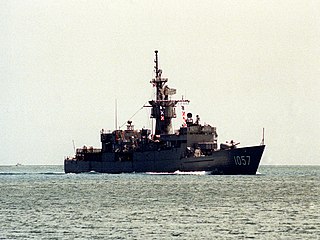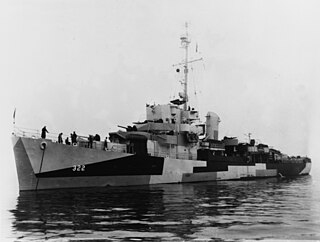
USS Pennsylvania (BB-38) was the lead ship of the Pennsylvania class of super-dreadnought battleships built for the United States Navy in the 1910s. The Pennsylvanias were part of the standard-type battleship series, and marked an incremental improvement over the preceding Nevada class, carrying an extra pair of 14-inch (356 mm) guns for a total of twelve guns. Named for the Commonwealth of Pennsylvania, she was laid down at the Newport News Shipbuilding and Drydock Company in October 1913, was launched in March 1915, and was commissioned in June 1916. Equipped with an oil-burning propulsion system, Pennsylvania was not sent to European waters during World War I, since the necessary fuel oil was not as readily available as coal. Instead, she remained in American waters and took part in training exercises; in 1918, she escorted President Woodrow Wilson to France to take part in peace negotiations.

USS Indiana (BB-58) was the second of four South Dakota-class fast battleships built for the United States Navy in the 1930s. The first American battleships designed after the Washington treaty system began to break down in the mid-1930s, they took advantage of an escalator clause that allowed increasing the main battery to 16-inch (406 mm) guns, but refusal to authorize larger battleships kept their displacement close to the Washington limit of 35,000 long tons (36,000 t). A requirement to be armored against the same caliber of guns as they carried, combined with the displacement restriction, resulted in cramped ships, a problem that was exacerbated as wartime modifications that considerably strengthened their anti-aircraft batteries significantly increased their crews.

USS Idaho (BB-42), a New Mexico-class battleship, was the fourth ship of the United States Navy to be named for the 43rd state. She was the third of three ships of her class. Built by the New York Shipbuilding Corporation of Camden, New Jersey, she was launched in June 1917 and commissioned in March 1919. She was armed with a battery of twelve 14-inch (356 mm) guns in four three-gun turrets, and was protected by heavy armor plate, with her main belt armor being 13.5 inches (343 mm) thick.

USS Maryland (BB-46), also known as "Old Mary" or "Fighting Mary" to her crewmates, was a Colorado-class battleship. She was the third ship of the United States Navy to be named in honor of the seventh state. She was commissioned in 1921, and serving as the flagship of the fleet, cruised to Australia, New Zealand, and Brazil.

USS West Virginia (BB-48) was the fourth dreadnought battleship of the Colorado class, though because Washington was cancelled, she was the third and final member of the class to be completed. The Colorado class proved to be the culmination of the standard-type battleship series built for the United States Navy in the 1910s and 1920s; the ships were essentially repeats of the earlier Tennessee design, but with a significantly more powerful main battery of eight 16-inch (406 mm) guns in twin-gun turrets. West Virginia was built between her keel laying in 1920 and her commissioning into the Navy in 1923. The ship spent the 1920s and 1930s conducting routine training exercises, including the typically-annual Fleet Problems, which provided invaluable experience for the coming war in the Pacific.

USS Leary (DD-158) was a Wickes-class destroyer in the United States Navy during World War II. She was named for Lieutenant Clarence F. Leary, posthumously awarded the Navy Cross in World War I.

USS Honolulu (CL-48) of the United States Navy was a Brooklyn-class light cruiser active in the Pacific War. Honolulu was launched in 1937 and commissioned in 1938. The ship served in the Battle of Tassafaronga, the Battle of Kula Gulf, the Battle of Kolombangara and the Battle of Peleliu. She was taken out of action by serious torpedo damage just before the Battle of Leyte Gulf. She was repaired, but not in time to rejoin the war. She was decommissioned in 1947 and was held in reserve until she was scrapped in 1959.

The Mahan-class destroyers of the United States Navy were a series of 18 destroyers of which the first 16 were laid down in 1934. The last two of the 18, Dunlap and Fanning, are sometimes considered a separate ship class. All 18 were commissioned in 1936 and 1937. Mahan was the lead ship, named for Rear Admiral Alfred Thayer Mahan, an influential historian and theorist on sea power.

The Wickes-class destroyers were a class of 111 destroyers built by the United States Navy in 1917–19. Along with the 6 preceding Caldwell-class and 156 subsequent Clemson-class destroyers, they formed the "flush-deck" or "four-stack" type. Only a few were completed in time to serve in World War I, including USS Wickes, the lead ship of the class.

USS Mahan (DD-102) was a Wickes-class destroyer built for the United States Navy. Commissioned in 1918, Mahan was a flush deck destroyer, and the first ship to be named for Rear Admiral Alfred Thayer Mahan. Her main battery consisted of four 4-inch/50 caliber guns.

USS Chew (DD-106) was a Wickes-class destroyer in the United States Navy during World War I and World War II.

USS Breese (DD-122) was a Wickes-class destroyer in the United States Navy during World War I, and later redesignated, DM-18 in World War II. She was the only ship named for Captain Kidder Breese.

The second USS Blakeley (DD–150) was a Wickes-class destroyer in the United States Navy, named for Captain Johnston Blakeley.

USS Trever (DD-339/DMS-16/AG-110) was a Clemson-class destroyer of the United States Navy in commission from 1922 to 1923 and from 1930 to 1945. Converted to a destroyer minesweeper in 1940, she served in the Pacific throughout World War II, including during the Japanese attack on Pearl Harbor, the Guadalcanal campaign, and the New Georgia campaign.

USS Mahan (DD-364) was the lead ship of the United States Navy's Mahan-class destroyers. The ship was named for Rear Admiral Alfred Thayer Mahan, a 19th-century naval historian and strategic theorist. Her design ushered in major advances over traditional destroyers. Among them were a third set of quadruple torpedo tubes, protective gun shelters, and emergency diesel generators. Along with a steam propulsion system that was simpler and more efficient to operate.

The Gridley-class destroyers were a class of four 1500-ton destroyers in the United States Navy. They were part of a series of USN destroyers limited to 1,500 tons standard displacement by the London Naval Treaty and built in the 1930s. The first two ships were laid down on 3 June 1935 and commissioned in 1937. The second two were laid down in March 1936 and commissioned in 1938. Based on the preceding Mahan-class destroyers with somewhat different machinery, they had the same hull but had only a single stack and mounted sixteen 21 inch (533 mm) torpedo tubes, an increase of four. To compensate for the increased torpedo armament weight, the gun armament was slightly reduced from five 5"/38 caliber guns (127 mm) to four. USS Maury (DD-401) made the highest trial speed ever recorded for a United States Navy destroyer, 42.8 knots. All four ships served extensively in World War II, notably in the Solomon Islands and the Battle of the Philippine Sea, with Maury receiving a Presidential Unit Citation.

USS Miller (FF-1091), originally (DE-1091) was a Knox-class destroyer escort in the United States Navy. She was named for Cook Third Class Doris "Dorie" Miller, who was awarded the Navy Cross for his actions at the attack on Pearl Harbor.

USS Carpenter (DD/DDK/DDE-825) was a Gearing-class destroyer of the United States Navy, named for Lieutenant Commander Donald M. Carpenter (1894–1940).

USS Rathburne (FF-1057) was a Knox-class frigate of the US Navy. Despite the different spelling, she was named for Continental Navy officer John Rathbun (1746-1782).

USS Newell was an Edsall-class destroyer escort built for the U.S. Navy during World War II. She served in the Atlantic and Pacific Oceans and provided destroyer escort protection against submarine and air attack for Navy vessels and convoys. Post war, she served in various capacities before being finally decommissioned.





















